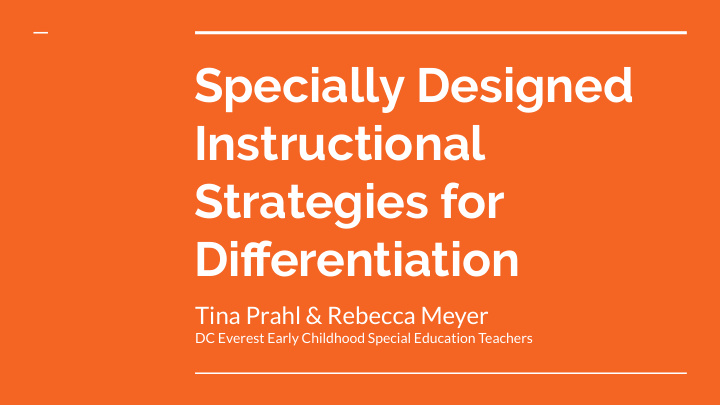



Specially Designed Instructional Strategies for Differentiation Tina Prahl & Rebecca Meyer DC Everest Early Childhood Special Education Teachers
1. Intro Let’s find out who is here... Teachers (Grade Level?) ➔ Support Staff ➔ Administrators ➔ School Psychologists ➔ Other?? ➔
Specially Designed Instruction The definition: Specially designed instruction adapts the content, methodology, or delivery of instruction to address the unique needs of the student. *HLP is High Leverage Practices.
https://dpi.wi.gov/sites/default/files/imce/sped/pdf/falleader16/11-%20Specially%20Designed%20Instruction.pdf
Let’s take a look at some helpful resources from nearby... https://www.doe.in.gov/sites/default/files/specialed/specially-designed-instruction. pdf Indiana https://www.ksde.org/Portals/0/SES/pubs/ConsiderationsForSpeciallyDesignedIns truction.pdf Kansas
What is ‘Special’ about Special Education? http://sss.usf.edu/resources/format/pdf/specially_designed_instruction.pdf
Environmental Support Alter the physical, social, and temporal environment to promote participation, engagement, and learning. What supports have been added to the environ- ment pictured?
Materials Adaptation Modify materials so that the child can participate as independently as possible. What kind of material adaptations do you see in the pictures? How does this promote independence? Can you think of some common items you use daily?
Activity Simplification Simplify a complicated task by breaking it into smaller parts or by reducing the number of steps. Talk at your table about a stand out activity that you modified to meet the needs of all the students in class.
Child Preferences If the child is not taking advantage of the available opportunities, identify and integrate the child’s preferences. What method have you used to monitor child preferences? Share at your table.
Special Equipment Use special or adaptive devices that allow the child to participate or increase the child’s level of participation. This includes homemade equipment or devices as well as commercially available therapeutic equipment. Do you work with any other related service providers with this as well? Please share your experiences!
Adult Support Have an adult intervene in an activity or routine to support the child’s participation and learning. Think about all the adults working with a particular student, how do you keep them all on the same page when a certain type of adult support works? How do you fade the supports?
Peer Support Utilize peers to help the child learn important objectives. Peer support can be such a great tool. How do you help encourage peer support?
Invisible Support Purposely arrange naturally occurring events within one activity. This one is tricky, we all do it naturally. Can you think about an activity you planned that has invisible supports within? Share out!
Activity Time Now that you have a better understanding of what SDI is, let’s get into groups! What ➔ You have been given situations during a major portion of a school day, read them out loud and place them where you feel the SDI is prevalent on your chart. Sharing ➔ Let everyone share, it’s possible that a situation fits more than one SDI area. If you’re stuck, call us over!
4. Closing Build confidence around the specially designed instruction that you design! Takeaways ➔ What is and is NOT specially designed instruction? How can you better support the students you work with? What’s next? ➔ Where do you find this information on the IEP forms? How can you better collaborate to make SDI consistent for students?
Good luck! We hope you’ll use these tips to go out and create intentional specially designed instruction to meet the needs of all the students you work with, now and forever!
Recommend
More recommend